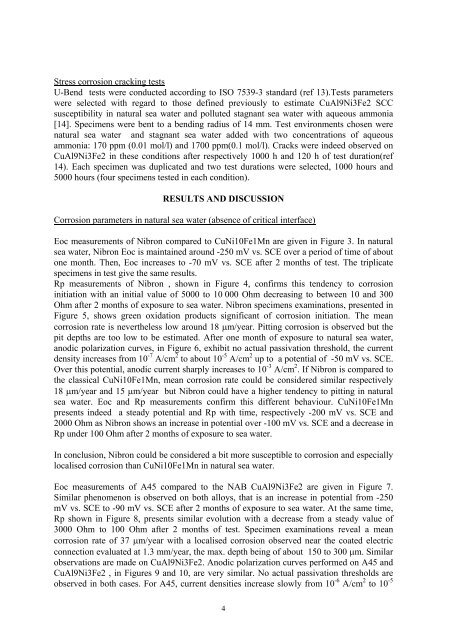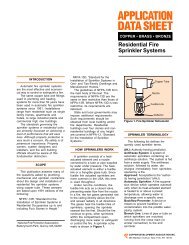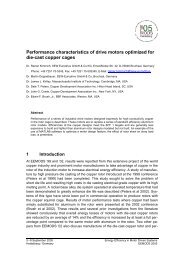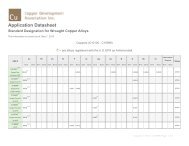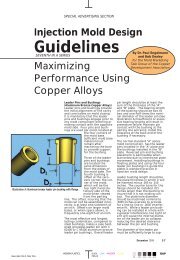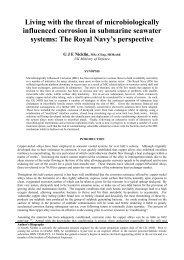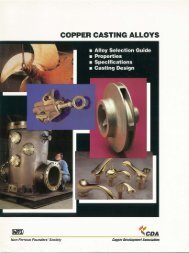Corrosion behaviour of copper alloys in natural sea water and ...
Corrosion behaviour of copper alloys in natural sea water and ...
Corrosion behaviour of copper alloys in natural sea water and ...
- No tags were found...
You also want an ePaper? Increase the reach of your titles
YUMPU automatically turns print PDFs into web optimized ePapers that Google loves.
Stress corrosion crack<strong>in</strong>g testsU-Bend tests were conducted accord<strong>in</strong>g to ISO 7539-3 st<strong>and</strong>ard (ref 13).Tests parameterswere selected with regard to those def<strong>in</strong>ed previously to estimate CuAl9Ni3Fe2 SCCsusceptibility <strong>in</strong> <strong>natural</strong> <strong>sea</strong> <strong>water</strong> <strong>and</strong> polluted stagnant <strong>sea</strong> <strong>water</strong> with aqueous ammonia[14]. Specimens were bent to a bend<strong>in</strong>g radius <strong>of</strong> 14 mm. Test environments chosen were<strong>natural</strong> <strong>sea</strong> <strong>water</strong> <strong>and</strong> stagnant <strong>sea</strong> <strong>water</strong> added with two concentrations <strong>of</strong> aqueousammonia: 170 ppm (0.01 mol/l) <strong>and</strong> 1700 ppm(0.1 mol/l). Cracks were <strong>in</strong>deed observed onCuAl9Ni3Fe2 <strong>in</strong> these conditions after respectively 1000 h <strong>and</strong> 120 h <strong>of</strong> test duration(ref14). Each specimen was duplicated <strong>and</strong> two test durations were selected, 1000 hours <strong>and</strong>5000 hours (four specimens tested <strong>in</strong> each condition).RESULTS AND DISCUSSION<strong>Corrosion</strong> parameters <strong>in</strong> <strong>natural</strong> <strong>sea</strong> <strong>water</strong> (absence <strong>of</strong> critical <strong>in</strong>terface)Eoc measurements <strong>of</strong> Nibron compared to CuNi10Fe1Mn are given <strong>in</strong> Figure 3. In <strong>natural</strong><strong>sea</strong> <strong>water</strong>, Nibron Eoc is ma<strong>in</strong>ta<strong>in</strong>ed around -250 mV vs. SCE over a period <strong>of</strong> time <strong>of</strong> aboutone month. Then, Eoc <strong>in</strong>creases to -70 mV vs. SCE after 2 months <strong>of</strong> test. The triplicatespecimens <strong>in</strong> test give the same results.Rp measurements <strong>of</strong> Nibron , shown <strong>in</strong> Figure 4, confirms this tendency to corrosion<strong>in</strong>itiation with an <strong>in</strong>itial value <strong>of</strong> 5000 to 10 000 Ohm decreas<strong>in</strong>g to between 10 <strong>and</strong> 300Ohm after 2 months <strong>of</strong> exposure to <strong>sea</strong> <strong>water</strong>. Nibron specimens exam<strong>in</strong>ations, presented <strong>in</strong>Figure 5, shows green oxidation products significant <strong>of</strong> corrosion <strong>in</strong>itiation. The meancorrosion rate is nevertheless low around 18 µm/year. Pitt<strong>in</strong>g corrosion is observed but thepit depths are too low to be estimated. After one month <strong>of</strong> exposure to <strong>natural</strong> <strong>sea</strong> <strong>water</strong>,anodic polarization curves, <strong>in</strong> Figure 6, exhibit no actual passivation threshold, the currentdensity <strong>in</strong>creases from 10 -7 A/cm 2 to about 10 -5 A/cm 2 up to a potential <strong>of</strong> -50 mV vs. SCE.Over this potential, anodic current sharply <strong>in</strong>creases to 10 -3 A/cm 2 . If Nibron is compared tothe classical CuNi10Fe1Mn, mean corrosion rate could be considered similar respectively18 µm/year <strong>and</strong> 15 µm/year but Nibron could have a higher tendency to pitt<strong>in</strong>g <strong>in</strong> <strong>natural</strong><strong>sea</strong> <strong>water</strong>. Eoc <strong>and</strong> Rp measurements confirm this different <strong>behaviour</strong>. CuNi10Fe1Mnpresents <strong>in</strong>deed a steady potential <strong>and</strong> Rp with time, respectively -200 mV vs. SCE <strong>and</strong>2000 Ohm as Nibron shows an <strong>in</strong>crease <strong>in</strong> potential over -100 mV vs. SCE <strong>and</strong> a decrease <strong>in</strong>Rp under 100 Ohm after 2 months <strong>of</strong> exposure to <strong>sea</strong> <strong>water</strong>.In conclusion, Nibron could be considered a bit more susceptible to corrosion <strong>and</strong> especiallylocalised corrosion than CuNi10Fe1Mn <strong>in</strong> <strong>natural</strong> <strong>sea</strong> <strong>water</strong>.Eoc measurements <strong>of</strong> A45 compared to the NAB CuAl9Ni3Fe2 are given <strong>in</strong> Figure 7.Similar phenomenon is observed on both <strong>alloys</strong>, that is an <strong>in</strong>crease <strong>in</strong> potential from -250mV vs. SCE to -90 mV vs. SCE after 2 months <strong>of</strong> exposure to <strong>sea</strong> <strong>water</strong>. At the same time,Rp shown <strong>in</strong> Figure 8, presents similar evolution with a decrease from a steady value <strong>of</strong>3000 Ohm to 100 Ohm after 2 months <strong>of</strong> test. Specimen exam<strong>in</strong>ations reveal a meancorrosion rate <strong>of</strong> 37 µm/year with a localised corrosion observed near the coated electricconnection evaluated at 1.3 mm/year, the max. depth be<strong>in</strong>g <strong>of</strong> about 150 to 300 µm. Similarobservations are made on CuAl9Ni3Fe2. Anodic polarization curves performed on A45 <strong>and</strong>CuAl9Ni3Fe2 , <strong>in</strong> Figures 9 <strong>and</strong> 10, are very similar. No actual passivation thresholds areobserved <strong>in</strong> both cases. For A45, current densities <strong>in</strong>crease slowly from 10 -6 A/cm 2 to 10 -54


